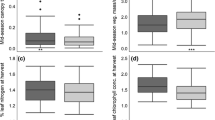Abstract
The capacity of individual branches to store water and fix carbon can have profound effects on inflorescence size and architecture, thus on floral display, pollination, and fecundity. Mixed regression was used to investigate the relation between branch length, a proxy for plant resources, and floral display of Fouquieria splendens (ocotillo), a woody, candelabraform shrub of wide distribution in arid North America. Long branches produced three times as many flowers as short branches, regardless of overall plant size. Long branches also had more complex panicles with more cymes and cyme types than short branches; thus, branch length also influenced inflorescence architecture. Within panicles, increasing the number of cymes by one unit added about two flowers, whereas increasing the number of cyme types by one unit added about 21 flowers. Because flower production is mediated by branch length, and because most plants have branches of various lengths, the floral display of individual plants necessarily encompasses a wide range of inflorescence size and structure.
Similar content being viewed by others
References
Bowers J.E. (2005) Influence of plant size and climatic variability on the floral biology of Fouquieria splendens (ocotillo). Madroño 52:158–165
Carlquist S. (2001) Wood anatomy of Fouquieriaceae in relation to habit, ecology, and systematics: nature of meristems in wood and bark. Aliso 19:137–163
Chaplin S.J., Walker J.L. (1982) Energetic constraints and adaptive significance of the floral display of a forest milkweed. Ecology 63:1857–1870
Darrow R.A. (1943) Vegetative and floral growth of Fouquieria splendens. Ecology 24:310–322
Felger R.S. (1980) Vegetation and flora of the Gran Desierto, Sonora, Mexico. Desert Plants 2:87–114
Goldberg D.E., Turner R.M. (1986) Vegetation change and plant demography in permanent plots in the Sonoran Desert. Ecology 67:695–712
Henrickson J. (1969) Anatomy of periderm and cortex of Fouquieriaceae. Aliso 7:97–126
Henrickson J. (1972) A taxonomic revision of the Fouquieriaceae. Aliso 7:439–537
Henrickson J. (1977) Leaf production and flowering in ocotillos. Cactus Succulent J. (U.S.) 49:133–137
Killingbeck K.T. (1990) Leaf production can be decoupled from root activity in the desert shrub ocotillo (Fouquieria splendens Engelm.). Am. Midland Nat. 124:124–129
La Mantia T., Barbera G., Inglese P. (1997) Effect of cladode shading on growth and ripening of fruits of cactus pear (Opuntia ficus-indica (L.) Miller). J. Horticult. Sci. 72:299–304
Nedoff J.A., Ting I.P., Lord E.M. (1985) Structure and function of the green stem tissue in ocotillo (Fouquieria splendens). Am. J. Bot. 72:143–151
Nicholls M.C. (1987) Spatial pattern of ovule maturation in the inflorescence of Echium vulgare: demography, resource allocation and the constraints of architecture. Biol. J. Linnean Soc. 31:247–256
Schaffer W.M., Schaffer M.V. (1979) The adaptive significance of variations in reproductive habit in the Agavaceae II: Pollinator foraging behavior and selection for increased reproductive expenditure. Ecology 60:1051–1069
Scott F.M. (1932) Some features of the anatomy of Fouquieria splendens. American Journal of Botany 19:673–678
Scott P.E. (1989) Ecological Consequences of Variation in Pollinator Availability: Ocotillo, Carpenter Bees, and Hummingbirds in Two Deserts, Ph.D. dissertation. Louisiana State University, Baton Rouge
Scott P.E., Buchmann S.L., O’Rourke M.K. (1993) Evidence for mutualism between a flower-piercing carpenter bee and ocotillo: use of pollen and nectar by nesting bees. Ecol. Entomol. 18:234–240
Sellers W.D., Hill R.H., Sanderson-Rae M. (1985) Arizona Climate. University of Arizona, Tucson, AZ
Shreve F. (1951) Vegetation of the Sonoran Desert. Carnegie Institution of Washington Publication no. 591. Carnegie Institution of Washington, Washington, D. C
Sprugel D.G., Hinckley T.M., Schaap W. (1991) The theory and practice of branch autonomy. Ann. Rev. Ecol. Systemat. 22:309–334
YSTAT. (2002) Statistics II. SYSTAT Software, Inc., Redmond, CA
Udovic D. (1981) Determinants of fruit set in Yucca whipplei: reproductive expenditure vs. pollinator availability. Oecologia 48:389–399
Waser N.M. (1979) Pollinator availability as a determinant of flowering time in ocotillo (Fouquieria splendens). Oecologia 39:107–121
Watson M.A., Casper B.C. (1984) Morphogenetic constraints on patterns of carbon distribution in plants. Ann. Rev. Ecol. Systemat. 15:233–258
Acknowledgements
Thanks to Margrit McIntosh and Steven McLaughlin for reading and commenting on earlier drafts.
Author information
Authors and Affiliations
Corresponding author
Rights and permissions
About this article
Cite this article
Bowers, J.E. Branch length mediates flower production and inflorescence architecture of Fouquieria splendens (ocotillo). Plant Ecol 186, 87–95 (2006). https://doi.org/10.1007/s11258-006-9114-7
Received:
Accepted:
Published:
Issue Date:
DOI: https://doi.org/10.1007/s11258-006-9114-7




